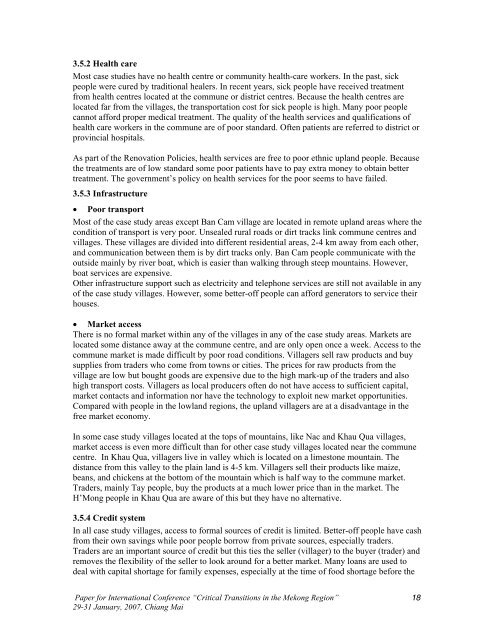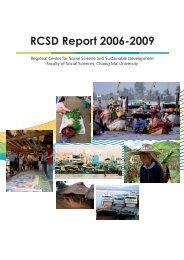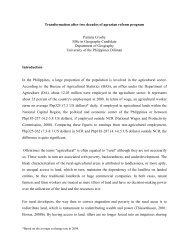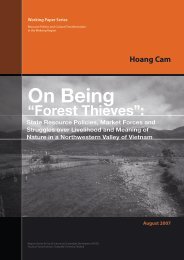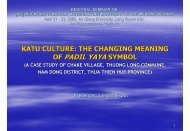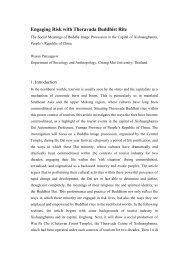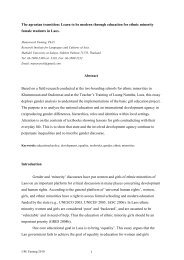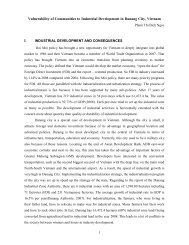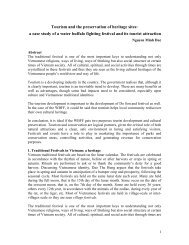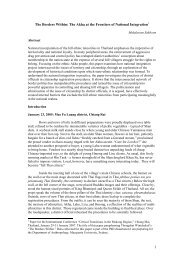The Impact of the Renovation Policies on the Livelihoods of ... - RCSD
The Impact of the Renovation Policies on the Livelihoods of ... - RCSD
The Impact of the Renovation Policies on the Livelihoods of ... - RCSD
You also want an ePaper? Increase the reach of your titles
YUMPU automatically turns print PDFs into web optimized ePapers that Google loves.
3.5.2 Health careMost case studies have no health centre or community health-care workers. In <str<strong>on</strong>g>the</str<strong>on</strong>g> past, sickpeople were cured by traditi<strong>on</strong>al healers. In recent years, sick people have received treatmentfrom health centres located at <str<strong>on</strong>g>the</str<strong>on</strong>g> commune or district centres. Because <str<strong>on</strong>g>the</str<strong>on</strong>g> health centres arelocated far from <str<strong>on</strong>g>the</str<strong>on</strong>g> villages, <str<strong>on</strong>g>the</str<strong>on</strong>g> transportati<strong>on</strong> cost for sick people is high. Many poor peoplecannot afford proper medical treatment. <str<strong>on</strong>g>The</str<strong>on</strong>g> quality <str<strong>on</strong>g>of</str<strong>on</strong>g> <str<strong>on</strong>g>the</str<strong>on</strong>g> health services and qualificati<strong>on</strong>s <str<strong>on</strong>g>of</str<strong>on</strong>g>health care workers in <str<strong>on</strong>g>the</str<strong>on</strong>g> commune are <str<strong>on</strong>g>of</str<strong>on</strong>g> poor standard. Often patients are referred to district orprovincial hospitals.As part <str<strong>on</strong>g>of</str<strong>on</strong>g> <str<strong>on</strong>g>the</str<strong>on</strong>g> <str<strong>on</strong>g>Renovati<strong>on</strong></str<strong>on</strong>g> <str<strong>on</strong>g>Policies</str<strong>on</strong>g>, health services are free to poor ethnic upland people. Because<str<strong>on</strong>g>the</str<strong>on</strong>g> treatments are <str<strong>on</strong>g>of</str<strong>on</strong>g> low standard some poor patients have to pay extra m<strong>on</strong>ey to obtain bettertreatment. <str<strong>on</strong>g>The</str<strong>on</strong>g> government’s policy <strong>on</strong> health services for <str<strong>on</strong>g>the</str<strong>on</strong>g> poor seems to have failed.3.5.3 Infrastructure• Poor transportMost <str<strong>on</strong>g>of</str<strong>on</strong>g> <str<strong>on</strong>g>the</str<strong>on</strong>g> case study areas except Ban Cam village are located in remote upland areas where <str<strong>on</strong>g>the</str<strong>on</strong>g>c<strong>on</strong>diti<strong>on</strong> <str<strong>on</strong>g>of</str<strong>on</strong>g> transport is very poor. Unsealed rural roads or dirt tracks link commune centres andvillages. <str<strong>on</strong>g>The</str<strong>on</strong>g>se villages are divided into different residential areas, 2-4 km away from each o<str<strong>on</strong>g>the</str<strong>on</strong>g>r,and communicati<strong>on</strong> between <str<strong>on</strong>g>the</str<strong>on</strong>g>m is by dirt tracks <strong>on</strong>ly. Ban Cam people communicate with <str<strong>on</strong>g>the</str<strong>on</strong>g>outside mainly by river boat, which is easier than walking through steep mountains. However,boat services are expensive.O<str<strong>on</strong>g>the</str<strong>on</strong>g>r infrastructure support such as electricity and teleph<strong>on</strong>e services are still not available in any<str<strong>on</strong>g>of</str<strong>on</strong>g> <str<strong>on</strong>g>the</str<strong>on</strong>g> case study villages. However, some better-<str<strong>on</strong>g>of</str<strong>on</strong>g>f people can afford generators to service <str<strong>on</strong>g>the</str<strong>on</strong>g>irhouses.• Market access<str<strong>on</strong>g>The</str<strong>on</strong>g>re is no formal market within any <str<strong>on</strong>g>of</str<strong>on</strong>g> <str<strong>on</strong>g>the</str<strong>on</strong>g> villages in any <str<strong>on</strong>g>of</str<strong>on</strong>g> <str<strong>on</strong>g>the</str<strong>on</strong>g> case study areas. Markets arelocated some distance away at <str<strong>on</strong>g>the</str<strong>on</strong>g> commune centre, and are <strong>on</strong>ly open <strong>on</strong>ce a week. Access to <str<strong>on</strong>g>the</str<strong>on</strong>g>commune market is made difficult by poor road c<strong>on</strong>diti<strong>on</strong>s. Villagers sell raw products and buysupplies from traders who come from towns or cities. <str<strong>on</strong>g>The</str<strong>on</strong>g> prices for raw products from <str<strong>on</strong>g>the</str<strong>on</strong>g>village are low but bought goods are expensive due to <str<strong>on</strong>g>the</str<strong>on</strong>g> high mark-up <str<strong>on</strong>g>of</str<strong>on</strong>g> <str<strong>on</strong>g>the</str<strong>on</strong>g> traders and alsohigh transport costs. Villagers as local producers <str<strong>on</strong>g>of</str<strong>on</strong>g>ten do not have access to sufficient capital,market c<strong>on</strong>tacts and informati<strong>on</strong> nor have <str<strong>on</strong>g>the</str<strong>on</strong>g> technology to exploit new market opportunities.Compared with people in <str<strong>on</strong>g>the</str<strong>on</strong>g> lowland regi<strong>on</strong>s, <str<strong>on</strong>g>the</str<strong>on</strong>g> upland villagers are at a disadvantage in <str<strong>on</strong>g>the</str<strong>on</strong>g>free market ec<strong>on</strong>omy.In some case study villages located at <str<strong>on</strong>g>the</str<strong>on</strong>g> tops <str<strong>on</strong>g>of</str<strong>on</strong>g> mountains, like Nac and Khau Qua villages,market access is even more difficult than for o<str<strong>on</strong>g>the</str<strong>on</strong>g>r case study villages located near <str<strong>on</strong>g>the</str<strong>on</strong>g> communecentre. In Khau Qua, villagers live in valley which is located <strong>on</strong> a limest<strong>on</strong>e mountain. <str<strong>on</strong>g>The</str<strong>on</strong>g>distance from this valley to <str<strong>on</strong>g>the</str<strong>on</strong>g> plain land is 4-5 km. Villagers sell <str<strong>on</strong>g>the</str<strong>on</strong>g>ir products like maize,beans, and chickens at <str<strong>on</strong>g>the</str<strong>on</strong>g> bottom <str<strong>on</strong>g>of</str<strong>on</strong>g> <str<strong>on</strong>g>the</str<strong>on</strong>g> mountain which is half way to <str<strong>on</strong>g>the</str<strong>on</strong>g> commune market.Traders, mainly Tay people, buy <str<strong>on</strong>g>the</str<strong>on</strong>g> products at a much lower price than in <str<strong>on</strong>g>the</str<strong>on</strong>g> market. <str<strong>on</strong>g>The</str<strong>on</strong>g>H’M<strong>on</strong>g people in Khau Qua are aware <str<strong>on</strong>g>of</str<strong>on</strong>g> this but <str<strong>on</strong>g>the</str<strong>on</strong>g>y have no alternative.3.5.4 Credit systemIn all case study villages, access to formal sources <str<strong>on</strong>g>of</str<strong>on</strong>g> credit is limited. Better-<str<strong>on</strong>g>of</str<strong>on</strong>g>f people have cashfrom <str<strong>on</strong>g>the</str<strong>on</strong>g>ir own savings while poor people borrow from private sources, especially traders.Traders are an important source <str<strong>on</strong>g>of</str<strong>on</strong>g> credit but this ties <str<strong>on</strong>g>the</str<strong>on</strong>g> seller (villager) to <str<strong>on</strong>g>the</str<strong>on</strong>g> buyer (trader) andremoves <str<strong>on</strong>g>the</str<strong>on</strong>g> flexibility <str<strong>on</strong>g>of</str<strong>on</strong>g> <str<strong>on</strong>g>the</str<strong>on</strong>g> seller to look around for a better market. Many loans are used todeal with capital shortage for family expenses, especially at <str<strong>on</strong>g>the</str<strong>on</strong>g> time <str<strong>on</strong>g>of</str<strong>on</strong>g> food shortage before <str<strong>on</strong>g>the</str<strong>on</strong>g>Paper for Internati<strong>on</strong>al C<strong>on</strong>ference “Critical Transiti<strong>on</strong>s in <str<strong>on</strong>g>the</str<strong>on</strong>g> Mek<strong>on</strong>g Regi<strong>on</strong>”29-31 January, 2007, Chiang Mai18


